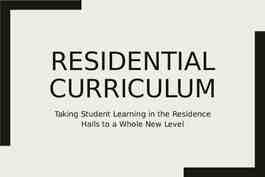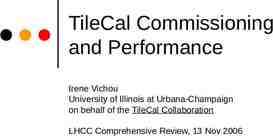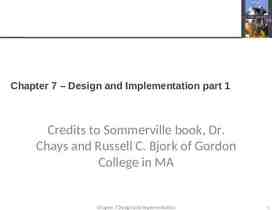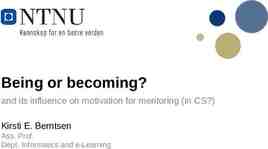Counselors As Mental Health Consultants Sharon Mitchell,
37 Slides297.85 KB

Counselors As Mental Health Consultants Sharon Mitchell, Jessalyn Klein, & Brad Linn University at Buffalo Counseling Services

Introductions Introduce presenters & context

Learning Objectives Understand types of mental health consultation taking place on a college campus Name most common concerns consultees bring to counseling centers Obtain recommendations for more effective consultations

Roles and Function of College Counseling Centers Counseling (individual, group, couples, family) Prevention & education Training Mental Health Consultation (growing role)

Mental Health Consultation Assumptions Consultation is: a problem solving & educational process dyadic or triadic voluntary collaborative temporary focused on mental health problems Adapted from Michael Dougherty (2009)

Assumptions cont’d. Consultation: helps both Consultee & Person of Concern (POC) is a relationship in which Consultant has no control over Consultee’s actions is a situation where Consultant may/may not have direct contact with POC entails working with Consultee to enhance Consultee’s effectiveness in assisting POC

Venues for Consultation on a College Campus After hours On-Call Crisis Intervention Students of Concern (SOC)/Behavioral Intervention/Threat Assessment Team External Consultations: Phone, e-mail, or face-to-face contact with concerned others (family, friends, faculty, staff)

How Was On-Call Service Used? Total number of calls: 58 Total number of consultees: 41 people* Average call length: 28 minutes, range 8-125 minutes Most consultees were students seeking assistance for him/herself (76%) 24% were others consulting about a student

Typical On-Call Consultee Typical POC was a Caucasian, heterosexual, undergraduate (male or female) who reported high level of general distress and was already a client at the counseling center

On-Call POC: Demographics (n 41) Gende r % Male 51 % Female 49 % Academic Status Undergradua te Graduate % 67 % Sexual Orientatio n % Heterosexu al LGBTQ % Caucasian 71 % 68 % Asian 17 % 15 % Black 5% Hispanic 5% Other 3% Age Unknown 12 Mean 23.2 % Range 1839 25 % International Students 19% Race/ Ethnicity 85% were current clients

On-Call Consultees: Description 100% 90% 80% 70% 60% 50% 40% 30% 20% 10% 0% Self (caller) Friend/ Partner Student No UB UB Affairs Affiliation Student Family

On-Call Consultations: Reasons 50% 40% 30% 20% 10% 0%

On-Call: Interventions Coaching (95%) Contracting for safety Short-term coping skills or problem-solving How to talk to someone you are concerned about Referred to Counseling Services (93%) Sent for hospital evaluation (7%) Referred to community services (2%) Other points of contact 27% Students of Concern 44% External Consultations

On-Call: Case Examples “My father is annoying me by calling all the time” “Holding on to distress all weekend”

Students of Concern Committee Representatives: University Police, Judicial Affairs, Residence Life, Health Services, Counseling Services, others as needed Meets weekly Hospital transports for alcohol or mental health Role of Counseling Services Rep

SOC Referral Source, Contact & Transports (n 136) Referral Source % Campus Police 44% Faculty/Staff 42% Student 5% Family 4% Student Affairs 4% No affiliation 2% Discussed at SOC % Discussed once 55 % Discussed once 44 % 1 distinct incident Alcohol or Mental Health Hospital Transport 7% 20%

Typical Student of Concern The typical SOC is a Caucasian, undergraduate, male who is not a client at the counseling center. He was referred to the committee by campus police or faculty/staff because of concern about his suicidal thoughts or behavior.

Students of Concern: Demographics Gender % Race/ Ethnicity % Male 57 % Caucasian Female Age 43 % 54 % Asian 27 % Black 12 % Minimum 18 Maximum 29 Mean 23.2 International Students 19% Other Client Status 5% % Hispanic 2% Non-client 60% Current client 27% Former client 13%

Reason for SOC Referral: 50% 40% 30% 20% 10% 0%

Students of Concern: Interventions* Student support coordinator 66% Counselor notified 38% Referred to counseling 17% Judicial hearing 14% Police follow-up13% Counseling Services outreach 8% Mandated evaluation 6% Referred off-campus 3% Referred to Health Services 2%

Students of Concern: Case Example “Victim of Home Invasion“ “Significant Disruption in the Apartments”

External Consultations: Overview Emails, calls, or in-person consultations with counseling staff during business hours 283 unique cases; 553 total consultations 36% had multiple consultations Only 1 student consulted about him/herself 24% were discussed at SOC meeting 5% had at least one On-Call Contact

External Consultation: Demographics Gender % Female 56 % Male 46 % Age 1% Transgende r Minimum 17 Maximum 49 Mean 23.4 Race/ Ethnicity Caucasian % 63 % Academic Status % Undergraduate 68% Graduate 27% NonClient Status matriculating 5% % Non-client 29 % Asian 19 % Black 7% Unknown 6% Hispanic 2% Current client 54 % Multiracial 2% Previous client 17 % International Students 18%

External Consultees: Description 100% 90% 80% 70% 60% 50% 40% 30% 20% 10% 0%

External Consultations: Reasons 50% 40% 30% 20% 10% 0%

External Consultations: Interventions Referred to Counseling Services 70% Coaching 24% Related to hospital evaluation 10% Referred off campus 9% Police assistance requested 4%

External Consultations: Case Examples “She was behaving very erratically” “My son has a history of anxiety and depression”

A Special Case: No-Name Consultations Note used when POC was not a student OR when student name was not shared 59 No-Name notes for 55 people

No-Name Consultations: Demographics Gender % Female 47% POC: Description Male 40% Another Person Unknow 13% n % POC Self Status No UB Affiliation 75 % % 24 % 47% UB Student 42% UB Faculty/Staff 7% Consultee Status % No UB Affiliation 43% Faculty/Staff 20% Family 15% Student 7% Non-UB Friends/Partners 2%

No-Name Consultations: Reasons 50% 40% 30% 20% 10% 0%

No-Name Consultations: Interventions 62% of consultees referred to offcampus providers 18% of SOCs referred to Counseling Services Only 9% of consultees were coached

Summary Thoughts on Data The following varied based on type of consultation: POC status Consultee status Problem type Intervention implemented Consultation is: time-consuming Total of 916 consultation contacts Requires case management tasks Requires thorough documentation Augments AND takes time from direct clinical services A pathway to counseling An Environmental Management Approach

Recommendations for Effective Consultations: Consultees Provide a student name & ID# or D.O.B Be willing to be a part of the solution & the plan Seek to understand limitations of the consultation

Recommendations for Effective Consultations: Consultants Benefits/necessity of having student names Ask for a call-back number or e-mail Follow up with an e-mail Be firm, direct, & honest. Discuss why confidentiality is not always possible Do risk assessment Validate consultee’s feelings & fears

Recommendations for Consultants Cont’d Assume the role of coach Be “the Calm in the Storm” – debrief later Provide developmental context Discuss limit setting & self care Have policies that support consultation Have strong partnerships Provide education to stakeholders PRIOR to a mental health emergency

Recommendations for Consultants Cont’d Staff training in consultation & crisis intervention TRUST that counselors want to minimize risk to individuals AND the campus community

Questions & Discussion






